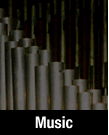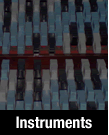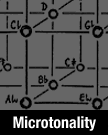Alois Hába
 The Czech composer Alois Hába (b. Vizovice, Moravia, 21 June 1893, d. Prague,
18 November 1973) was, together with Leos Janácek and Bohuslav Martinu, the
most distinctive figure in 20th-century modern Czech music.
The Czech composer Alois Hába (b. Vizovice, Moravia, 21 June 1893, d. Prague,
18 November 1973) was, together with Leos Janácek and Bohuslav Martinu, the
most distinctive figure in 20th-century modern Czech music.
He began his musical career in his childhood as a violinist, playing Moravian
folk music in his father's folk band. His mother, Theresia Trckova, was an
excellent folk singer who taught Hába peasant songs from the Valassko region,
the intervals of which sometimes deviated from the semitone system.
These folk songs, particularly those of his native East Moravia, were
his first major and lasting influence. Later he developed his own archives of
recorded folk songs which he then studied. He analysed the folk modal scales
in the chapter entitled "Greek Scales and Folk Songs from the Slovacko
District" in his book Neue Harmonielehre. Hába found in folk songs the
first stimuli for the building of his modal and microtonal system in both
musical theory and practice.
His traditional compositional training took him to Berlin and later to Vienna,
where he proofread scores of Schönberg and Janácek for Universal Edition.
He studied Schönberg's Harmonielehre, and read the essays on music and
the Sketch of a New Esthetic of Music by Ferruccio Busoni of
whose private musical circle in Berlin he was a member.
From Schönberg, Hába adopted the principle of equality between dissonance and
consonance. Both Hába and Schönberg considered the minor second, major
seventh and other dissonances to be intervals equal to the consonant third,
sixth, etc.
He began composing in quartertones after reading a newspaper article about
them in 1917. Also just after World War I, and independently of Hába, the
Russian Ivan Wyschnegradsky began composing
in quartertones. They were the first composers who applied this means
systematically and would continue to do so during the rest of their lives.
Hába's first composition in the quartertone system is his Second String
Quartet. Thanks to his account in his musical "autobiography" Mein Weg zur
Viertel- und Sechsteltonmusik (Düsseldorf 1971) we know relatively much
about its history of origin. The work was written in less than two weeks,
during the spring of 1920, as in a flash. After some hesitation Hába decided
to present his first quartertone composition to his teacher, Franz Schreker.
He was quite surprised, asked if Hába had gone mad, but took a good look at it.
Schreker was appointed as director of the Musikhochschule in Berlin shortly
after and Hába and many of his fellow students followed him to Berlin.
There the first performance of the Second String Quartet took place on
28 November 1922, by the Havemann-Kwartett.
Hába started and led a department of Microtonal Music at the
Prague Conservatory from 1924 until 1951. He also created new instruments such
as 1/4-tone pianos (1924-1931), 1/6-tone harmonium (1936, see photo),
1/4-tone clarinet (1924) and trumpet (1931), and finally a 1/4-tone guitar in
1943, for which he wrote several suites and a song cycle. He is easily the most
prolific of twentieth century's microtonal composers, having written
extensively for string quartet, orchestra and keyboards. He also wrote a
fully-grown quartertone opera, The Mother (1930), about the life of the
peasant population in the Moravian countryside.
 Another distinctive feature of Hába's music is his "athematism", denying the
classical-romantic thematic work based on a stereotyped repetition of
motifs, themes and larger structural units in the composition. Hába decided to
adhere to these principles to extend the possibilities of expression. In his
compositions, he works with unrepeated themes and motifs, the expressive
effect of which he enhances with the help of tone differentiation (ranging
from semitones to the finest fifth-tone microtones), a free selection and a
logical thinking of intervals in distinctive musical ideas.
Another distinctive feature of Hába's music is his "athematism", denying the
classical-romantic thematic work based on a stereotyped repetition of
motifs, themes and larger structural units in the composition. Hába decided to
adhere to these principles to extend the possibilities of expression. In his
compositions, he works with unrepeated themes and motifs, the expressive
effect of which he enhances with the help of tone differentiation (ranging
from semitones to the finest fifth-tone microtones), a free selection and a
logical thinking of intervals in distinctive musical ideas.
In his String Quartet in Fifth-tone System No. 16, op. 98 (1967), Hába assumed
a new task, one which, in the genre of microtonal music, the Dutch school
headed by physicist Adriaan Daniël Fokker (whom Hába met at the UNESCO
Congress in Paris in 1958) and composer Henk Herman Badings had tried to solve
before him and consisting in the adoption, as the basic unit of microtonal
system of his composition, of the fifth-tone (1/31th of an octave,
approximating Aristoxenos' diesis), i.e. an interval smaller than the
quarter-tone from which it differs also in that it cannot be replaced
enharmonically. Hába was convinced that by using the fifth-tones he could
bridge the difference between this type of micro-interval music and the
semitone system.
Alois Hába employed the quarter-tone guitar as accompaniment in several vocal
compositions dating from the 1930s. The instrument soon captivated him so much
that he wrote two suites for it, one at the end of 1943 and the other in the
second half of 1947. A Prague guitarist Cisar did a trial performance of the
fourth movement only of the technically demanding and musically complex
quarter-tone guitar Suite No. 1. Hába the duly applied the experience acquired
in the process while devising the much simpler form of the Suite No. 2 for quarter-tone guitar, op. 63. The
Suite is athematic in terms of form. Its five movements' adherence to the
uniform key of E minor (and the eponymous E major), rhythmic distinctiveness of
the motives of its fast movements, and lyric tunefulness of the slow ones,
account for the work's formal succinctness and accessibility. The melodies,
which prevail over chordal treatment, make use of all 24 intervals of the
quarter-tone scale.

Melle Carrillo, Alois Hába, Adriaan Fokker,
Julián Carrillo, Ivan Wyschnegradsky.
Paris, 1958.
Listen to music of Hába on this website in
Ogg-format.
Literature
- A. Hába: Mein Weg zur Viertel- und Sechstel-tonmusik.
Gesellschaft zur Förderung der systematischen Musikwissenschaft,
Düsseldorf, 1971, 125 pages. Filmkunst Musikverlag, München, 1986.
- A. Hába: Harmonické základy ctvrttónové soustavy. German
translation Neue Harmonielehre des diatonischen, chromatischen Viertel-,
Drittel-, Sechstel- und Zwölftel-tonsystems by the author. Fr. Kistner &
C.F.W. Siegel, Leipzig, 1927. Universal, Wien, 1978. Revised by Erich
Steinhard, Grundfragen der mikrotonalen Musik; Bd. 3, Musikedition Nymphenburg
2001, Filmkunst-Musikverlag, München, 251 pages.
English translation
Alois
Hába's 'Neue Harmonielehre des diatonischen, chromatischen, Viertel-, Drittel-,
Sechstel- und Zwölftel-Tonsystems' by Suzette Mary Battan. PhD diss.,
Eastman School of Music, Rochester, 1980, 366 pages.
- Kees Arntzen: "Uit de diepste lagen van de historie. De kwarttoonsmuziek
van Alois Hába", Mens en Melodie vol. 51, jul/aug. 1996, pp. 322-325.
- Jirí Vyslouzil: "Alois Hába und das moderne Wien",
Österreichische Musikzeitschrift 1993, pp. 476-477.
- Sigrun Schneider: Mikrotöne in der Musik des 20. Jahrhunderts.
Untersuchungen zu Theorie und Gestaltungsprinzipien moderner Kompositionen
mit Mikrotönen. Orpheus, Band 15, Verlag für systematische Musikwissenschaft,
Bonn-Bad Godesberg, 1975, 317 pages.
|










 The Czech composer Alois Hába (b. Vizovice, Moravia, 21 June 1893, d. Prague,
18 November 1973) was, together with Leos Janácek and Bohuslav Martinu, the
most distinctive figure in 20th-century modern Czech music.
The Czech composer Alois Hába (b. Vizovice, Moravia, 21 June 1893, d. Prague,
18 November 1973) was, together with Leos Janácek and Bohuslav Martinu, the
most distinctive figure in 20th-century modern Czech music. Another distinctive feature of Hába's music is his "athematism", denying the
classical-romantic thematic work based on a stereotyped repetition of
motifs, themes and larger structural units in the composition. Hába decided to
adhere to these principles to extend the possibilities of expression. In his
compositions, he works with unrepeated themes and motifs, the expressive
effect of which he enhances with the help of tone differentiation (ranging
from semitones to the finest fifth-tone microtones), a free selection and a
logical thinking of intervals in distinctive musical ideas.
Another distinctive feature of Hába's music is his "athematism", denying the
classical-romantic thematic work based on a stereotyped repetition of
motifs, themes and larger structural units in the composition. Hába decided to
adhere to these principles to extend the possibilities of expression. In his
compositions, he works with unrepeated themes and motifs, the expressive
effect of which he enhances with the help of tone differentiation (ranging
from semitones to the finest fifth-tone microtones), a free selection and a
logical thinking of intervals in distinctive musical ideas.